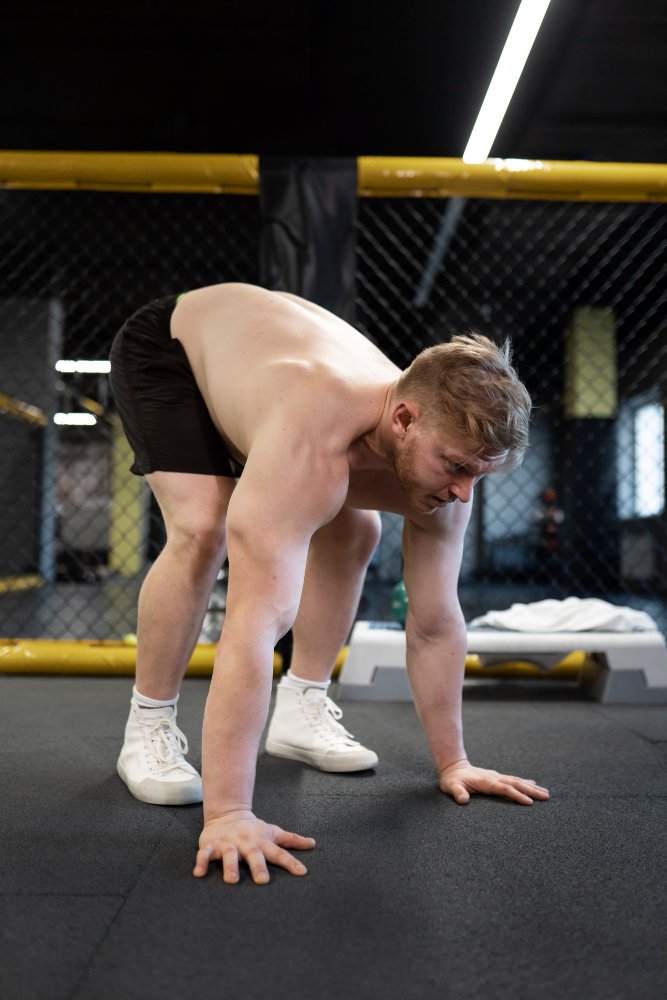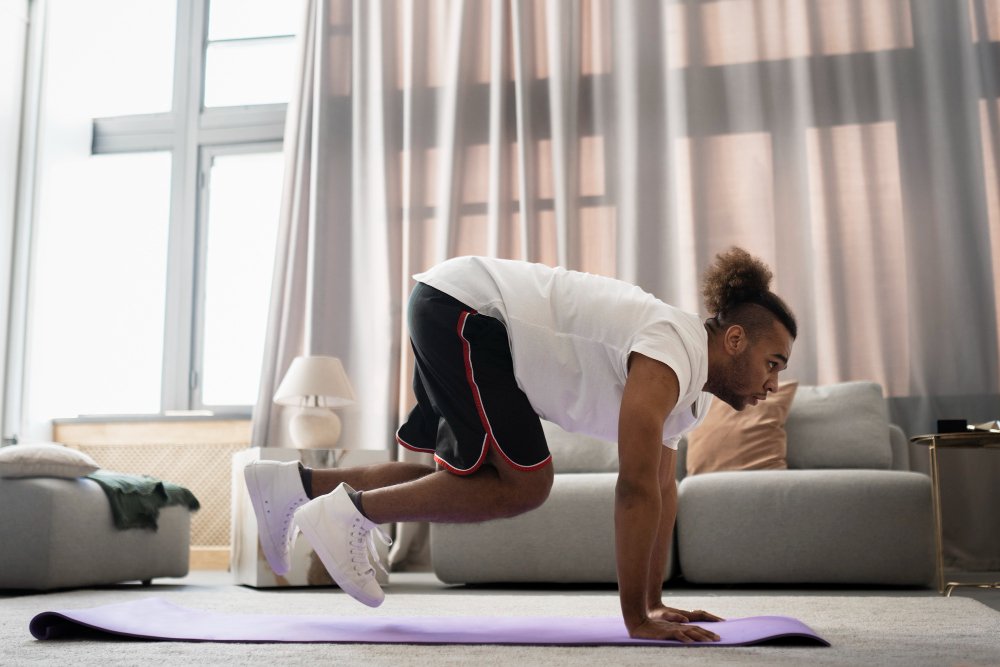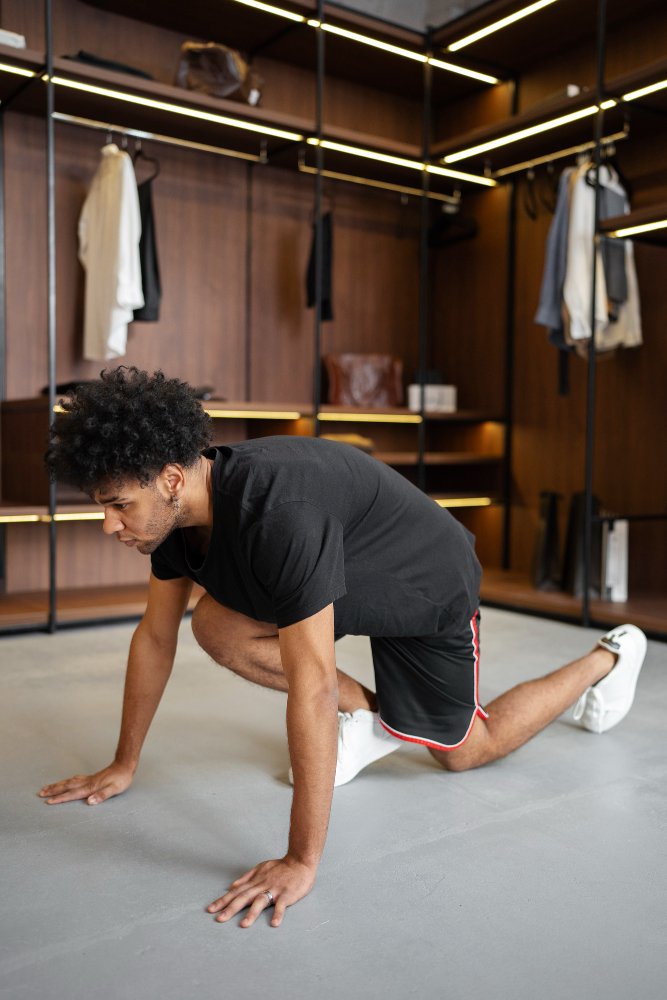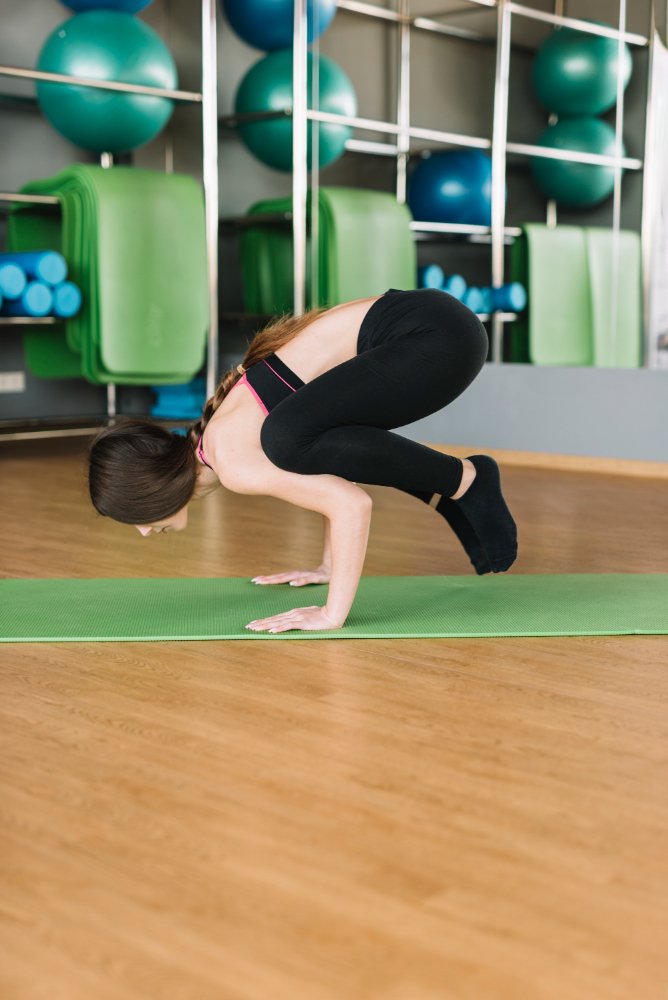The frog stand, also known as the crow pose in yoga, is a foundational bodyweight exercise that targets various muscle groups while also improving balance and body control. This article will explore the benefits of practicing this, how to perform it correctly, different variations and progressions, safety measures, and its integration into different fitness routines.
Benefits of Practicing Frog Stand
The frog stand offers numerous benefits for both physical and mental health. It strengthens the arms, shoulders, and core muscles, improves balance and coordination, enhances focus and concentration, and boosts self-confidence. Additionally, it can help in developing a strong mind-muscle connection, which is essential for overall athletic performance.
How to Perform Frog Stand Correctly
To perform this exercise correctly, follow these steps:

Proper Form and Alignment
- Begin in a squat position with your feet hip-width apart.
- Place your hands on the ground shoulder-width apart, fingers spread wide, and palms pressing firmly into the floor.
- Bend your elbows slightly and lean forward, shifting your weight onto your hands.
- Slowly lift your hips up, engaging your core muscles, and bring your knees to rest on the backs of your arms, near the armpits.
- Keep your gaze forward, focusing on a point on the ground to maintain balance.
- Hold the position for as long as comfortable, breathing deeply.
- To release, gently lower your feet back to the ground and return to the starting position.
Common Mistakes to Avoid
- Allowing the elbows to splay outwards.
- Collapsing the chest and rounding the back.
- Leaning too far forward or backward.
- Holding the breath instead of breathing rhythmically.
- Overarching the lower back.
By maintaining proper form and alignment, you can maximize the effectiveness of the frog stand while minimizing the risk of injury.
Muscles Worked
This exercise primarily targets the muscles of the upper body, including the shoulders, arms, chest, and core. It also engages the muscles of the lower body, including the quadriceps and hip flexors, to stabilize the position.
Frog Stand Variations
There are several variations of this that can add variety to your workouts and target different muscle groups. Some popular variations include:
- Crane pose: Extending the arms fully and lifting the feet off the ground, balancing on the hands.
- One-legged frog stand: Lifting one leg off the ground while maintaining the position with the other leg.
- Side crow pose: Twisting the torso and resting one knee on the opposite elbow while balancing on the hands.
Experimenting with these variations can challenge your strength and balance in new ways and prevent workout plateaus.
Progressions for Beginners
If you’re new to the exercise, start with these progressions to build strength and confidence:
- Tuck frog stand: Begin with the knees tucked closer to the chest to reduce the weight on the arms and wrists.
- Supported frog stand: Place a block or cushion under the forehead for support while practicing the position.
- Wall-assisted frog stand: Perform this facing a wall for added stability and balance.
Gradually progress to more advanced variations as you become more comfortable with the basic exercise.
Tips for Improving Frog Stand
- Practice consistently: Incorporating into your regular workout routine to build strength and stability over time.
- Focus on form: Pay attention to proper alignment and engage the core muscles to maintain balance.
- Breathe deeply: Remember to breathe rhythmically throughout the exercise to prevent fatigue and improve endurance.
- Be patient: Progress may be slow at first, but with dedication and practice, you’ll see improvements in strength and balance.
Incorporating Frog Stand into Your Workout Routine

You can incorporate this into your workout routine in several ways:
- Include it as part of a bodyweight circuit, alternating with other exercises such as push-ups, squats, and lunges.
- Use it as a warm-up exercise to activate the muscles of the upper body and core before more intense workouts.
- Practice it as a standalone exercise, aiming to increase the duration of the hold with each session.
By integrating this into your routine, you can improve overall strength, stability, and body control.
Precautions and Safety Measures
While ths is generally safe for the most people, it’s essential to take precautions to prevent injury:
- Warm up properly before attempting this to prepare your muscles and joints.
- Start with easier progressions and gradually increase the difficulty as you build strength and confidence.
- Listen to your body and stop if you experience any pain or discomfort.
- Avoid practicing the frog stand on hard surfaces to reduce the risk of wrist injuries.
- Consult with a fitness professional if you have any pre-existing medical conditions or concerns about your ability to perform the exercise safely.
By following these safety measures, you can minimize the risk of injury and enjoy the benefits of this exercise.
Strength and Balance
This is an excellent exercise for building both upper body strength and balance. By challenging the muscles of the arms, shoulders, and core, it helps improve stability and control throughout the body. Incorporating frog stand variations and progressions into your workouts can further enhance strength gains and balance skills.
For Muscle up: Mastering the Bar Muscle Up Progression
Advanced Frog Stand Techniques
For those looking to take their practice to the next level, there are several advanced techniques to explore:
- Extended frog stand: Straighten the arms fully and lift the feet off the ground, balancing on the hands with legs extended.
- Handstand transition: From this position, transition into a handstand by pressing through the palms and kicking the legs up overhead.
- Planche progression: Work on building strength and stability in the shoulders and core to progress to more challenging gymnastics moves like the planche.
These advanced techniques require patience, dedication, and consistent practice to master but can significantly enhance upper body strength and body control.
Frog Stand Challenges and Competitions

For fitness enthusiasts looking for an extra challenge, there are frog stand challenges and competitions held in gyms and online communities. Participants showcase their strength and balance by holding this position for extended periods or performing advanced variations with precision and control. These challenges can be a fun way to test your skills, connect with other fitness enthusiasts, and stay motivated in your training.
Frog Stand as a Yoga Pose
In yoga, the frog stand is known as the crow pose or bakasana. It’s often included in yoga sequences to build arm strength, improve balance, and cultivate focus and concentration. Practicing the crow pose regularly can help yogis progress to more advanced arm balances and inversions, making it a valuable addition to any yoga practice.
Incorporating Frog Stand into Yoga Practice
Yogis can incorporate the frog stand into their practice in several ways:
- Include it as part of a vinyasa flow sequence, transitioning into and out of the crow pose smoothly.
- Use it as a preparatory pose for more challenging arm balances and inversions like the handstand or headstand.
- Practice holding the crow pose for longer durations, focusing on deepening the breath and maintaining steady concentration.
By integrating this into yoga practice, practitioners can enhance upper body strength, balance, and mindfulness on and off the mat.
Conclusion
This is a versatile bodyweight exercise that offers numerous benefits for strength, balance, and body control. Whether you’re a beginner looking to build foundational strength or an advanced practitioner seeking new challenges, incorporating the frog stand into your workout routine or yoga practice can help you achieve your fitness goals. Remember to start slowly, focus on proper form and alignment, and listen to your body to prevent injury and maximize the benefits of this dynamic exercise.
FAQs (Frequently Asked Questions)
- Is the frog stand suitable for beginners? Yes, beginners can start with easier variations and progressions to build strength and confidence gradually.
- Can I practice the frog stand if I have wrist pain? If you experience wrist pain, it’s essential to consult with a healthcare professional before attempting. You may need to modify the exercise or avoid it altogether until your wrists are fully healed.
- How long should I hold the frog stand position? Beginners can start with short holds of 10-20 seconds and gradually increase the duration as they become more comfortable and confident in the position.
- Are there any alternatives to the frog stand for building upper body strength? Yes, there are several alternatives, including push-ups, dips, and plank variations, that target similar muscle groups and can be incorporated into your workout routine.
- Can the frog stand help with handstand progressions? Yes, practicing can help build the necessary strength and balance for more advanced handstand progressions, but it’s essential to progress gradually and focus on proper form to avoid injury.

